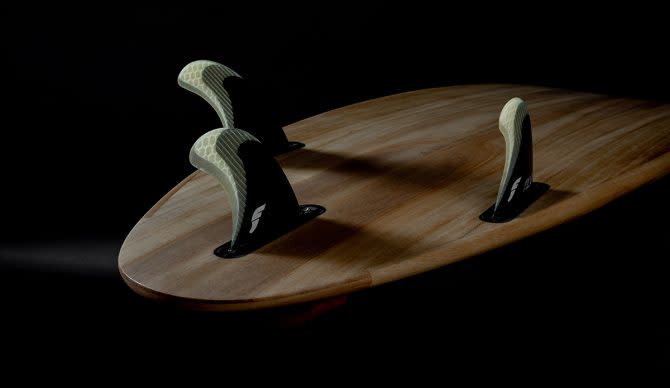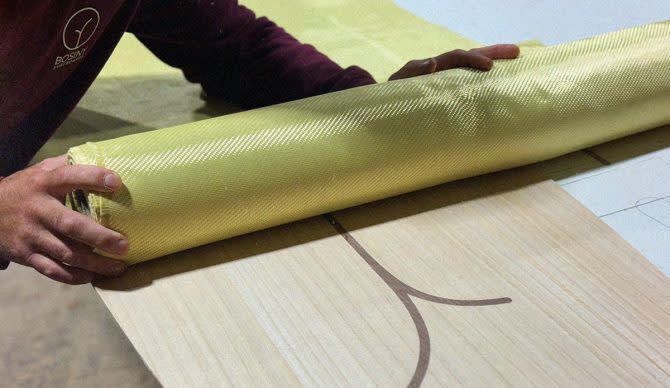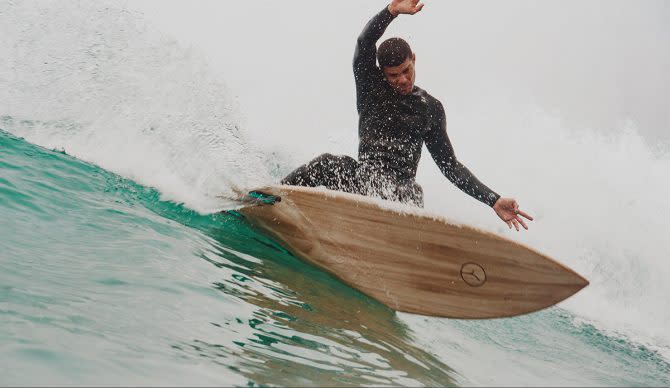Could Sustainable, High-Performance Wooden Surfboards Become A Thing?

What do poly-paraphenylene terephthalamide and Paulownia have a common? Poly-paraphenylene terephthalamide, as you undoubtedly know, is better known as Kevlar. Its high tensile strength-to-weight ratio is good for stopping bullets but has applications ranging from bicycle tires to racing sails. Paulownia is a light, fast-growing wood (a tree can grow 20 feet per year) that also has a very high strength-to-weight ratio.
In the Bosiny Surfboards shaping bay near Arrafina, Portugal, about 150 miles south of Lisbon, the shaper and noted furniture designer and sculptor Alex Knight has melded these two materials into surfboards that he says provide high-performance and sustainability.
“I’ve done a lot of composite material work with my furniture design, but with surfboards, we found the carbon fiber was too brittle and the mix of Kevlar and carbon too heavy,” Knight told The Inertia. “However, with a hollow paulownia core, a thin layer of Kevlar on the underside of the timber skin and bio-resin on top, it gave us the right mix of weight-to-flex.”
Wooden boards aren’t new. Firewire is just one brand that has a range of paulownia wooden deck and bottom-skinned boards, all be it with an EPS core. Tom Wegener has been singing and surfing its praises as far back as 2003. Varuna in Australia too has been a leading exponent. They are largely known for their aesthetic appeal and are used mainly for logs and retro designs.
However, Knight believes the Bosiny range has enough new technology to warrant a patent and be a potential game changer. “We want to change the perception of what wood surfboards can do and what our technology can provide, especially in the performance realm, which wooden boards aren’t usually associated with.”

Knight uses a 3D, laser-cut paulownia torsion box with a laminated parabolic rail stringer. They claim that utilizes far less wood than traditional hollow boards, making it much lighter, with more flex. They are then finished with bio epoxy resin and a single layer of four-ounce fiberglass.
The boards weigh the same as the equivalent of PU construction (the performance model comes in at 2.9kg), yet Knight boasts that none of the boards he’s made have snapped. And that includes one punter who ran over his in a Toyota Hilux. It’s enough for them to offer a no-snap guarantee. He says the Kevlar also provides high impact resistance and shape “memory.” Some of his well-used boards are two or three years old and have yet to show any sign of pressure dings, he says. You might say they are bulletproof.

The longevity helps on the sustainability front and by volume, 99 percent of the boards are made from organic material. The paulownia is sustainably grown by a family-run business located just over the border in Spain.
While sustainability is a key plank, if you’ll pardon the pun, the shapers are keen to stress the performance aspect. They’ve had Brazilian-born European-based QS shredders Halley Batista and Caina Souza as test pilots, and the pair have been effusive in the backing of the boards. Batista, one of European surfing’s better aerialists, is yet to buckle one. “Surfers won’t trust the tech until they see pros ripping on them and doing airs,” says Knight. “So far the testing and feedback has been great.”
The catch, and there is always a catch, is the price. The models start at around €1200, ($1,300), and some models are advertised up to $1,800. The label is also in its relative infancy, and credibility will only come as more and more surfers try the surfboards out. However, if all the claims of sustainability, longevity and performance ring true, they believe it’s a price many surfers will be prepared to pay.
The post Could Sustainable, High-Performance Wooden Surfboards Become A Thing? first appeared on The Inertia.

